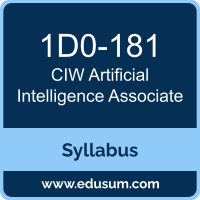 Use this quick start guide to collect all the information about CIW Artificial Intelligence Associate (1D0-181) Certification exam. This study guide provides a list of objectives and resources that will help you prepare for items on the 1D0-181 CIW Artificial Intelligence Associate exam. The Sample Questions will help you identify the type and difficulty level of the questions and the Practice Exams will make you familiar with the format and environment of an exam. You should refer this guide carefully before attempting your actual CIW Artificial Intelligence Associate certification exam.
Use this quick start guide to collect all the information about CIW Artificial Intelligence Associate (1D0-181) Certification exam. This study guide provides a list of objectives and resources that will help you prepare for items on the 1D0-181 CIW Artificial Intelligence Associate exam. The Sample Questions will help you identify the type and difficulty level of the questions and the Practice Exams will make you familiar with the format and environment of an exam. You should refer this guide carefully before attempting your actual CIW Artificial Intelligence Associate certification exam.
The CIW Artificial Intelligence Associate certification is mainly targeted to those candidates who want to build their career in Artificial Intelligence domain. The CIW Artificial Intelligence Associate exam verifies that the candidate possesses the fundamental knowledge and proven skills in the area of CIW Artificial Intelligence Associate.
CIW Artificial Intelligence Associate Exam Summary:
| Exam Name | CIW Artificial Intelligence Associate |
| Exam Code | 1D0-181 |
| Exam Price | $175 (USD) |
| Duration | 90 mins |
| Number of Questions | 54 |
| Passing Score | 74.07% |
| Schedule Exam |
PSI Store CIW Shop |
| Sample Questions | CIW Artificial Intelligence Associate Sample Questions |
| Practice Exam | CIW 1D0-181 Certification Practice Exam |
CIW 1D0-181 Exam Syllabus Topics:
| Topic | Details |
|---|---|
| Domain 1: Ideas of AI |
- AI Fundamentals
- Reasoning
- Social and Business
- AI Project Planning
|
| Domain 2: Data Management |
- Describe a simple model of the data processing cycle (input-processing-output) - Describe data gathering to create new datasets - Describe dataset selection techniques and methods - Describe the importance of dataset curation - Explain how to decide between data file formats such as XML, CSV, JSON - Explain the importance of feature engineering - Explain various sampling plans, including subsampling - Explain what data distribution shift is and its implications in production - Find and filter out missing or N/A data<br> - Give an example of the use of multi-modal data in an AI application - Identify univariate and multivariate outliers in a dataset - Modify existing script to clean data |
| Domain 3: Algorithms |
- Define main algorithms of different machine learning methods - Describe classification, approximation, inference optimization, recognition, search families of reasoning algorithms - Describe how generative, pretrained language models generate text - Describe how parameters like Temperature affect the generative output of large language models - Distinguish deep learning from other learning algorithms - Explain Maximum Likelihood Estimation (MLE) - Explain search algorithms and operators commonly used in AI - Explain the algorithm for fitting bivariate linear regression models - Explain the difference between classification and regression - Explain the effect of computational complexity on solving algorithms - Explain the k-means clustering algorithm starting values - Explain the major distinctions between algorithms to fit supervised and unsupervised models - Identify the differences between informed and uninformed search techniques |
| Domain 4: Legal, Ethical and Privacy Issues |
- Describe privacy concerns related to AI - Describe the role of ethics and philosophy in AI both explicitly and implicitly - Determine the difference between credible and unreliable information sources - Explain copyright issues arising from generative models trained on massive datasets scraped from websites - Explain how selection bias in the training data might affect the model fairness in production - Explain the ethical responsibility of AI designers and developers |
| Domain 5: Machine Learning |
- Identify supervised, unsupervised, reinforcement, and transfer learning types of machine learning and problems they solve - Compare the model complexity of a decision tree alone versus one with a Random Forest - Describe how predictions or decisions are made with AI models - Describe how unstructured observational data can be used to train an AI model - Describe the issue of "black-box" ML models - Describe the limitations of AI supporting natural interactions - Evaluate a prediction model where outcome of interest is a continuous variable - Explain bias-variance trade-off in a machine learning model - Explain how ensemble methods work (e.g., Bagging, Boosting, Random Forests) - Explain how to include a categorical variable into a prediction model - Explain k-fold cross validation and its purpose - Explain the concepts of 'agent' and 'action' in reinforcement learning - Explain the concepts of underfitting and overfitting in data modeling - Explain the specialized vocabulary of ML (e.g., testing/training data, labels, naive Bayes, one- hot coding, etc.) - Explain when logistic (rather than linear) regression should be used |
| Domain 6: Statistics |
- Define a cost function, given the outcome, to train a neural network - Distinguish Bayesian and frequentist approaches to probability - Estimate the mean and standard error of the mean given the data - Explain definition, purpose and application of bootstrapping - Explain null hypothesis significance testing methodology - Explain the curse of dimensionality - Explain the sources of uncertainty in a prediction model - Give examples for continuous, binary, categorical and ordinal data types |
To ensure success in CIW Artificial Intelligence Associate certification exam, we recommend authorized training course, practice test and hands-on experience to prepare for CIW Artificial Intelligence Associate (1D0-181) exam.
